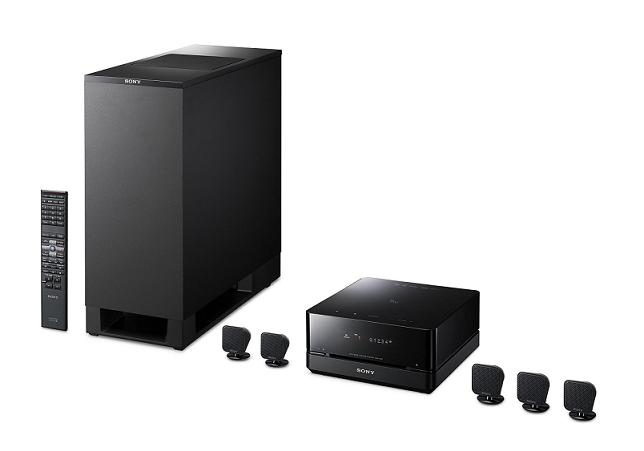
The Sony Bravia DAV-IS10 is the stealth bomber of home theater systems. You won’t even know it’s there, thanks to five tiny micro-satellite speakers, each of which is about the size of a baby’s fist. The desktop PC-size subwoofer sits in the corner of a room and pumps out some pretty intense bottom end, while the digital amp/DVD player does some fancy digital processing to pump out 450W of impressively clear audio and HDMI goodness. The whole thing kind of melts into your living room, which means no complaints from your S.O. Plenty of cool connectivity features (some of which are optional) make this a painless way to get into 5.1-channel surround sound.
The main reason I’ve been avoiding getting a home theater system is that I live in a modest apartment in New York City, and I’m really not interested in having more gear and wires in my living room that I already have. But when I tested out the Sony Bravia DAV-IS10 home theater in a box, I couldn’t help but be impressed at how little space the whole thing takes up.
Setting it all up takes about 10 minutes: Just plop the digital amp (with built-in slot-loading DVD player and AM/FM tuner) on top of your TV set and connect it to the subwoofer via a very thick cable. The sub plugs into an outlet and provides power to the amp as well as to the five little speakers.
The system comes with long enough speaker wires that I had no trouble running the rear surround satellites around to the back of my living room and placing them on the arms of my couch. The speakers are so small, though, that even just the weight of the wires can cause them to move or fall, so you might want to secure them down with some double-sided tape.
The back of the amp, which is about the size of a Mac Mini but a little taller (8 7/16″ x 4 1/8″ x 18 1/8″), has optical and digital coaxial inputs, analog RCA and coaxial inputs, an HDMI connector, and composite and component video outputs. There’s also a Digital Media Port for hooking up optional accessories like Sony’s iPod dock, a home networking adapter, or a Bluetooth module. The HDMI component can upscale video to 720p and 1080i, but you’ll need something else if you’re going for 1080p, which is unfortunate.
On the amp’s top, there are hidden touch-sensitive controls that light up when you press them and disappear when the unit is switched off, giving the IS10 a New York kind of sleekness. The remote controls all functions, and the TV-based interface is easy to read and a cinch to navigate.
In the name of convenience, Sony includes a little microphone that attaches to the amp so you can run the IS10’s auto calibration feature. Place the mic where you’ll be sitting (preferably at head height), and each speaker’s volume will automatically adjust to give you balanced sound. It’s a lot easier and quicker than adjusting each speaker manuall, and the system does a fine job of it.
The system’s digital signal processor can distribute multichannel audio in a few different ways, including Dolby Pro Logic and Pro Logic II, Dolby Digital, DTS, AV Sync, and Omnidirectional (puts everything through all speakers), as well as regular old stereo. So I tested the sound quality using a mix of music and movies, and all turned out better than I expected given the speakers’ golf-ball sizes.
In The Fifth Element there are a few scenes that really emphasize the surround mix (especially the taxi chase), and the IS10’s subwoofer and satellites kept me on the edge of my couch. I found that the movie sounded best with Dolby Pro Logic II (Movie), though Crouching Tiger, Hidden Dragon‘s forest fight, with its swishing trees and and clanging swords, sounded better on the A.F.D. Multichannel setting.
I expected stereo musicto sound muddled and honky, but when I set the sound profile to A.F.D. Standard, John Coltrane’s Blue Train came out crisp and clear, with nicely extended highs, plenty of midrange detail, and surprisingly well-defined bass. The Pro Logic II (Music) setting didn’t do very well though; it tried to distribute the sound across all the speakers and muddied up the bass. The Omnidirectional setting is kind of interesting for music — everything comes out evenly from all the speakers. I could see this being handy for a party where you’ve got lots of people packed into a small room.
The picture quality from the analog and HDMI video outputs is excellent, and I didn’t run into any upscaling problems, though be aware that if you’ve got a 1080p TV, you’re only getting up to 1080i out of the IS10. If you’ve got other Sony Bravia components, you can control them all via the amp/DVD. You can even save different setup profiles so you can have your DVD/surround setup, your cable TV setup, or your music setup available with a single button press.
Overall this is a pretty hot-looking product that fits in best in tight quarters. At $800, it’s even a bargain given the surprising sound quality and versatility. The home networking adapter is an essential extra if you’re using this as your main music system, since it lets you stream tunes from your computer wirelessly, though the optional speaker stands seem hilariously out of place for a system this small.